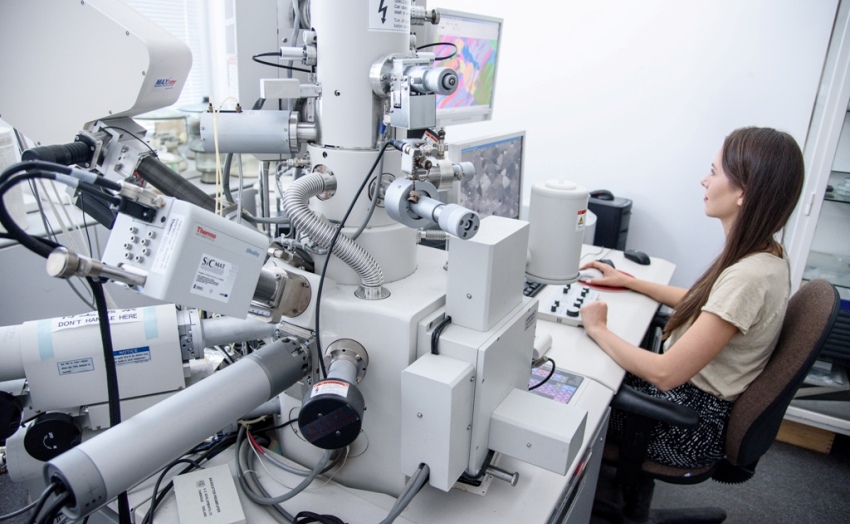Home » Research » Research groups »
Nanocrystalline and ultrafine grained materials
Nanocrystalline and ultrafine grained materials are a new class of structural and functional materials characterized by a polycrystalline structure with a grain size of hundreds of nanometers (ultrafine grained materials) or tens of nanometers (nanocrystalline materials).
Owing to extremely small grain sizes, they exhibit very high strength at ambient temperatures and the ability of superplastic flow at high strain rates at elevated temperatures.
Research activities
- Understanding the mechanism of grain refinement and the formation of ultrafine grained structure by various processes of severe plastic deformation;
- Understanding the relationship between the structure and mechanical properties of ultrafine grained materials;
- Uniformity of the microstructure and properties in micro- and macro-scale;
- Superplasticity and ability of deep drawing manufacturing;
- Characteristics of grain boundaries and their influence on the properties of ultrafine grained and nanocrystalline materials;
- Precipitation processes in ultrafine grained and nanocrystalline structures, the role of structural defects, in particular grain boundary types, in these processes;
- Diffusion processes in ultrafine grained and nanocrystalline materials, formation of diffusion layers, phase transitions;
- Benign joining of ultrafine grained and nanocrystalline materials allowing to preserve their refined structure:
- Friction stir welding;
- Phenomenon of melting point depression in nanomultilayer systems and its application in low temperature joining processes;
- The performance of ultrafine grained and nanocrystalline materials – i.e. corrosion resistance, electrical conductivity, wear resistance, biocompatibility;
- Ferritic and austenitic steels reinforced with nano-oxides for thermonuclear and nuclear power applications;
-
Synthesis of metal matrix composites by means of severe plastic deformation methods.
Research offer
- Investigation of the microstructure on a micro-, nano- and atomic scale by means of electron microscopy techniques;
-
Corrosion tests.
Projects
- OPUS-9 ”Fundamental understanding of melting point depression in nanomultilayer systems” 2016-2019
- OPUS-12 ”Ultrafine grained plates with low anisotropy and the capabilities of deep drawing and superplastic deformation at high strain rates” 2017-2020
- OPUS-15 “AlCrFe complex metallic alloys as novel and versatile coatings – fundamental understanding of their structure and properties” 2019-2022
- SONATA-7 ”The application of novel methods of electron microscopy in three-dimensional structure reconstruction of oxide layers” 2015-2018
- SONATA-8 ”Recrystallization and grain growth in severely deformed austenitic stainless steel” 2015-2019
- SONATINA-1 ”Synthesis of novel hybrid materials by high pressure torsion” 2017-2020
- SONATINA-1 ”Optimization of the microstructure of aluminium alloys in terms of precipitation hardening effectiveness” 2017-2020
- PRELUDIUM-10 ”The influence of the manufacture on a microstructure and mechanical properties of an Al alloy plates with ultrafine grained structure” 2016-2019
- PRELUDIUM-14 ”Ultrafine grained copper bars for conductive structural components” 2018-2021
- TechMatStrateg-1 ”Manufacturing technologies of materials and structures used for X and gamma radiation detection, using low defect uniform (Cd,Mn)Te crystals with high resistivity to radiation caused defects” 2018-2021
- TechMatStrateg-2 “Development of low-waste explosive cladding technology and processing technology of multilayer, high strength, light and super light materials with reactive and functional layers as well as plates cladded explosively with reactive metals and its alloys” 2019-2022
- Polish-Austrian cooperation (Ministry of Science and Higher Education) ”The impact of the stacking fault energy of nanomaterials on phenomena during annealing at the high hydrostatic pressure” 2018-2020
-
Polonium (Ministry of Science and Higher Education) ”The study of the plasticity of alumina at different scales during in situ experiments in electron microscopes” 2018-2020
Research collaboration
National collaboration
- Poland, WUT, Faculty of Production Engineering | Prof. Lech Olejnik
- Poland, Institute of High Pressure Physics PAS | Mariusz Kulczyk, PhD
- Poland, Rzeszow University of Technology | Prof. Jan Sieniawski
- Poland, Institute of Physics PAS | Prof. Andrzej Mycielski
International collaboration
- UK, University of Southampton | Prof. Terence Langdon
- Austria, University of Vienna | Prof. Michael Zehetbauer
- Japan, Hokkaido University | Prof. Masato Ohnuma
- Japan, Toyama University | Prof. Kenji Matsuda
- Germany, Fraunhofer Institute IKTS | Prof. Ehrefried Zschech
- Switzerland, EMPA | Prof. Jolanta Janczak-Ruch
- Switzerland, EPFL | Prof. Marco Cantoni
- Norway, NTNU | Prof. Randi Holmestad
-
France, INSA | Prof. K. Masenelli-Varlot
Contact
Professor Małgorzata Lewandowska
malgorzata.lewandowska@pw.edu.pl
+48 22 234 87 35
Division of Materials Design

